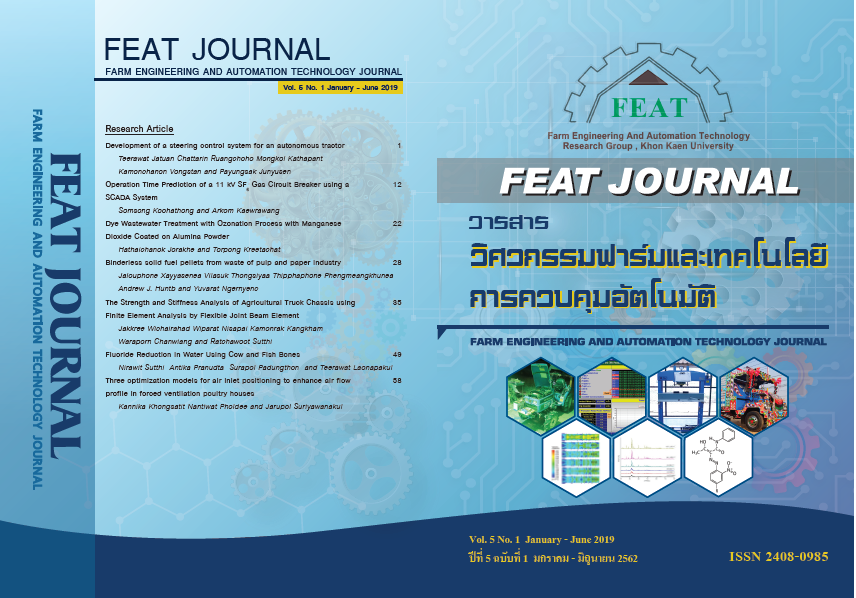Three optimization models for air inlet positioning to enhance air flow profile in forced ventilation poultry houses
Main Article Content
บทคัดย่อ
This research aims to find the suitable location for installing side wall air inlet of the poultry house, which minimum Temperature Humidity and Velocity Index: THVI, by using three optimization techniques. The first is using Adaptive Differential Evolution Algorithm in MATLAB, sampling by Latin Hypercube Sampling design in pure quadratic model sample. Second technique is using GRG Nonlinear algorithm in Microsoft Excel Solver add-ins, sampling by Latin Hypercube Sampling design in Central Composite Design (CCD). The last one is using Nonlinear Programming by Quadratic Lagrangian (NLPQL) which is Design exploration function in AnsysTM14.5 program, sampling by Latin Hypercube Sampling design in full quadratic model sample. After the side wall air inlet installation lengths have been calculated from each methodology above, simulation model then be made to simulate air flow of each approach by computational fluid dynamic (CFD). The best result then be chosen, by analyzing air speed consistency throughout the poultry house, to conduct real situation experiment to compare the efficiency with the original poultry house. The best simulation result has THVI of 28.38 ºC with 0.84 standard deviation. And the experiment result shows that; average air velocity increase to 2.8 m/s from 2.2 m/s, air change rate increase to 53 ACH from 34 ACH (in case of maximum ventilation) and fan efficiency increase to 94.77% from 61.22% in poultry house without air inlet installation.
Article Details
วารสารวิศวกรรมฟาร์มและเทคโนโลยีควบคุมอัตโนมัติ (FEAT Journal) มีกําหนดออกเป็นราย 6 เดือน คือ มกราคม - มิถุนายน และ กรกฎาคม - ธันวาคม ของทุกปี จัดพิมพ์โดยกลุ่มวิจัยวิศวกรรมฟาร์มและเทคโนโลยีควบคุมอัตโนมัติ คณะวิศวกรรมศาสตร์มหาวิทยาลัยขอนแก่น เพื่อเป็นการส่งเสริมและเผยแพร่ความรู้ ผลงานทางวิชาการ งานวิจัยทางด้านวิศวกรรมศาสตร์และเทคโนโลยีพร้อมทั้งยังจัดส่ง เผยแพร่ตามสถาบันการศึกษาต่างๆ ในประเทศด้วย บทความที่ตีพิมพ์ลงในวารสาร FEAT ทุกบทความนั้นจะต้องผ่านความเห็นชอบจากผู้ทรงคุณวุฒิในสาขาที่เกี่ยวข้องและสงวนสิทธิ์ ตาม พ.ร.บ. ลิขสิทธิ์ พ.ศ. 2535
เอกสารอ้างอิง
[2.] Lott BD, Simmons JD, May JD. Air velocity and high temperature effects of broiler performance. Journal of Poultry Science. 1998; 77: 391-393.
[3.] Plavnik I, Yahav S. The effect of environmental temperature on broiler chickens subjected to growth restriction at an early age. Journal of Poultry Science. 1998; 77: 870-872.
[4.] Yahav S, Straschnow A, Vax E, Razpakovski V, Shinder D. Air velocity alters broiler performance under harsh environmental conditions. Journal of Poultry Science. 2001; 80: 724-726.
[5.] David S. Poultry health and management. Department of Clinical Veterinary Medicine. 4th ed. Blackwell Science: Oxford; 2000.
[6.] Yahav S, Straschonow A, Pleavnik I, Hurwitz S. Blood system response of chickens to changes in environmental temperature. Journal of Poultry Science. 1997; 76: 627-633.
[7.] Gunhan T, Demir V, Yagcioglu AK. Evaluation of the suitability of some local materials as cooling pads. Biosystems Engineering. 2007; 96(3): 369-377.
[8.] Malli A, Seyf HR, Layeghi M, Sharifian S, Behravesh H. Investigating the performance of cellulosic evaporative cooling pads. Energy Conversion and Management. 2011; 52: 2598-2603.
[9.] Boulard T, Roy JC, Fatnassi H, Kichah A, I-B.Lee. Computer fluid dynamics prediction of climate and fungal spore transfer in a rose greenhouse. Biosystems Engineering. 2010; 74(2): 280-292.
[10.] Bartzanas T, Kacira M, Zhu H, Karmakar S, Tamimi E, Katsoulas N, et al. Computational fluid dynamics applications to improve crop production systems. Computers and Electronics in Agriculture. 2013; 93: 151–167.
[11.] Franco A, Valera DL, Pena A, Perez AM. Aerodynamic analysis and CFD simulation bof several cellulose evaporative cooling pad used in Mediterranean greenhouses. Computers and Electronics in Agriculture. 2011; 76: 218-230.
[12.] Stinn JP, Shepherd TA, Xin H. Optimizing Tunnel Ventilation Systems for Summer Conditions [Internet]. Iowa state university: Animal Industry Report; 2014 [Cited 2018 March 16]. Available from: https://lib.dr.iastate.edu/cgi/viewcontent.cgi?referer=https://www.google.co.th/&httpsredir=1&article=2004&context=ans_air
[13.] Kwon KS, Lee IB, Zhang GQ, Ha T. Computational fluid dynamics analysis of the thermal distribution of animal occupied zones using the jet-drop-distance concept in a mechanically ventilated broiler house. Biosystems Engineering. 2015; 136: 51-68.
[14.] Vidal VB, Guijarro E, Balasch S, Torres AG. Application of computational fluid dynamics to the prediction of airflow in a mechanically ventilated commercial poultry building. Biosystems Engineering. 2008; 100: 105 – 116.


